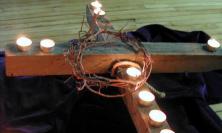The liturgies of the Easter Triduum are rich and evocative, and the depth of their meaning and impact can only be discovered if we participate fully in them. Sr Anouska Robinson-Biggin FCJ identifies three invitations that we are called to respond to over these days, and offers an Ignatian guide to how we might answer those calls in prayer and action.
In the final days of Lent, the liturgies of Holy Week issue each of us with an invitation to ‘be with’ Jesus in a special way. This time, described by Pope Francis as ‘the heart of the mystery of our salvation’ (General Audience, Ash Wednesday, 5 March 2014) is a time to pray for the grace to be truly with Jesus, becoming conscious not just of what he suffered but of the impact that his life, death and resurrection have on me. Monty Williams SJ emphasises the importance of this closeness and response to Jesus in his book Spiritual Intimacy, ‘it is a huge grace to be simply present... ...without running away, falling back into ourselves, or trying to remedy the situation.’[i]
I think there are three verbs through which we can understand the dynamic of the Triduum and our response to it: remember, stay and rejoice. Pondering these words and the way in which they describe our participation in the Easter Triduum can help us become ever more conscious of our response to this great point in our liturgical year. As Louis Savary says: ‘In order to be conscious, it is not enough to be simply awake or aware of what is going on. To be truly conscious, you also need to respond appropriately to what you are experiencing.’[ii] Having received so much, what do we desire to do or be in return?
Remember
At the heart of the Holy Thursday liturgy is the act of remembering, bringing to mind the Last Supper. The evening Mass of the Lord’s Supper is the only Mass of the day. The white or gold vestments remind us that this is a joyful occasion, as does the ringing of the bells at the Gloria. Our celebration is rooted in our remembering that Jesus and his friends were also holding a celebration at that time, of Passover: remembering Israel being set free by God, their release from slavery in Egypt and in time into the Promised Land. We are reminded of that first Passover in the First Reading of the Mass (Exodus 12:1-8, 11-14). But for Jesus, this celebration was so much more. As Monty Williams SJ recounts:
With the meal, [Jesus] gives a way of being united with God that is more than just memory and ritual. He makes the bread and wine of that Passover meal his body and blood. He shares that with his companions. He ensures that his essence remains with those with whom he shares his life and mission. We become what we eat. We become partakers of the same relationship he has with the Father.[iii]
Do you feel you ‘become what you eat’ when you receive Holy Communion? If so, what difference does this make to you? Do you feel like you partake in the same relationship that Jesus had with his father, that of beloved child? If you struggle with this, what gets in the way?
However, the Mass of the Lord’s Supper is not only about remembering the institution of the Eucharist sacramentally. In the gospel we hear about another act that we are called to participate in, in Jesus’s memory: the washing of the feet. The disciples were shocked, unnerved by Jesus, their master, washing their feet. Peter especially struggled with this and initially refused, though with Jesus’s guidance he eventually allowed his feet to be washed, even if he did not understand fully what Jesus was doing.
We may not understand fully, either, and so it is important to take the time to pray with the washing of the feet. Ignatius would invite us to imagine the scene. If you were at such a celebration, where would you be? Who would be there with you? How would Jesus be involved? Would you let him wash your feet? It can be hard to appreciate what that was really like: when the priest and members of the congregation re-enact this at Maundy Thursday Mass, the ‘disciples’ will often have pre-washed their feet out of consideration for the priest, but the feet of Jesus’s disciples would have been dusty, dirty, maybe even smelly. Yet still Jesus knelt before them and acted as their servant.
Maybe you have no problem allowing Jesus to wash your feet, and so in your prayer, maybe Jesus is leading you to wash the feet of others. Whose feet would they be? Can you do it?
If you want to explore this way of engaging with the washing of the feet, here is a framework for an Ignatian imaginative contemplation:
Stay
Good Friday: the Stations of the Cross, walks of witness, the Celebration of the Passion of the Lord – they are all about staying with Jesus, a call that even the disciples struggled with: after Jesus’s arrest in the Garden of Gethsemane, they fled. The liturgy of Good Friday is not a Mass, the hosts that we receive at Holy Communion were consecrated on Maundy Thursday night. This is a solemn day, a day of fasting and abstinence as prescribed by the Church. The liturgy of Good Friday commemorates the passion and death of Jesus, and the sombre mood of the service reflects this. The service begins and ends in silence. The priests enter and their first action is to lie prostrate before the altar expressing the ‘grief and sorrow of the Church’ (Paschale Solemnitatis no. 65). The people kneel.
As we hear once more the Passion of our Lord Jesus Christ, we are reminded of what Jesus went through, freely and out of love, for us. Ignatius would ask us at this point to be with Jesus in his suffering, not to take it on ourselves, but to be fully present to him in his anguish. The Stations of the Cross offer an example of what it means to do this: Veronica, in the midst of Jesus’s long walk to Calvary, stepped out of the crowd and performed an act of kindness in response to his agony. Have you ever done that for someone? If so, how?
As we pray the General Intercessions, which have been handed down by tradition and articulate our prayers for all of the people and needs of our world, we are reminded that Christ’s Passion encompasses not just you or me, but the whole of creation.
As we venerate the cross and show our love for the one who loved us so much, enough to die for us, we remember the many ways in which Jesus continues to suffer today, through people we know, people we don’t know and all of the natural world. The Lampedusa Crosses are a remarkable symbol of this. They are made out of the wood of boats carrying people fleeing conflict, poverty, ecological crises and abuses of power, boats that sunk on their way to safety. The 2013 General Chapter Directions of the FCJ Sisters stated: ‘As women of the Church, standing at the foot of contemporary crosses, we are channels of hope, love and mercy in our villages, towns and cities.’ As we live Good Friday this year, call to mind the contemporary crosses of which you are aware. Can you be present with Jesus at the feet of them, like Mary and the women? Can you be the disciple Jesus loves and be a channel of hope, love and mercy in your village, town or city?
Holy Saturday, too is a day on which we ‘stay’: a quiet day, a day at the tomb. Jesus is dead; the one who loved us unto death is gone. Ignatius invites retreatants to spend this day with Mary, the Mother of Jesus, to be with her at this time; to use all of our senses to experience what this day was like for her, before we move, as the sun sets, into the time of great rejoicing.
Rejoice
In the evening of Holy Saturday, when all goes dark, we gather together to celebrate the Easter Vigil. This liturgy re-tells the story of our salvation, from creation to resurrection.
We begin outside or in the porch of the church, with the Liturgy of Light. A fire is lit and, from that, so too the Easter candle. Bit by bit, light spreads throughout the Church and in a beautifully symbolic way, we see the victory of the Light of Christ over the darkness of the church and, symbolically, our world. The vestments are once again white (or gold), holy water is back in the stoups and the bells will ring again. We hear in the Exultet, the song of praise after the Liturgy of Light, that ‘this is the night’, and so it is: the night above all others when we celebrate our redemption, our freedom from sin and death and our joy at being children of the resurrection. In the Liturgy of the Word we are reminded of our covenantal relationship with God that has been sealed with the life, death and resurrection of Jesus. If there are new members of the Church to be baptised, this also happens at this Mass, and they are welcomed into the body of the Church as it is revitalised through the new life of Easter. The Easter Vigil is a liturgy of great joy, a joy that cannot only be ours. We must share it and so at the end of the Mass we are sent out on mission, to ‘glorify God by our lives’. Do we do this? Can you, having heard and lived the story of your salvation and mine, be transformed by it this Easter?
‘Becoming conscious changes you’, writes Louis Savary,[iv] and so it should be with the Easter Triduum. Our understanding of and being with Jesus in his suffering, and then sharing the joy of his resurrection, should change us, it should change me. I can choose not to engage with what I see, hear, experience in the liturgies of the Easter Triduum, but that in itself is a response – and that changes me, too.
So what will your response be this Easter? What do you desire it to be? Talk to God, as a friend talks to a friend, about the days you are about to spend together.
Sr Anouska Robinson-Biggin FCJ is responsible for Young Adult Ministries at the Mount Street Jesuit Centre.
[i] Monty Williams SJ, The Gift of Spiritual Intimacy (Novalis Press, 2009), pp. 203-4.
[ii] Louis Savary, The New Spiritual Exercises: In the Spirit of Pierre Teilhard de Chardin (Paulist Press, 2011), p.19.
[iii] Williams, The Gift of Spiritual Intimacy, p. 208.
[iv] Savary, The New Spiritual Exercises





